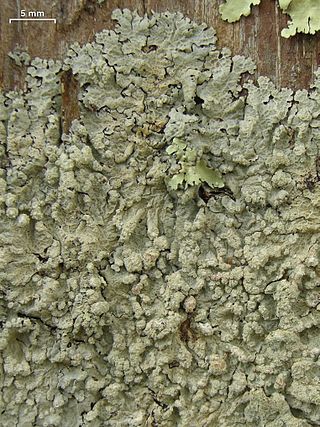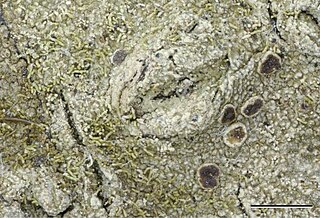
Parmelia is a genus of medium to large foliose lichens. It has a global distribution, extending from the Arctic to the Antarctic continent but concentrated in temperate regions. There are about 40 species in Parmelia. In recent decades, the once large genus Parmelia has been divided into a number of smaller genera according to thallus morphology and phylogenetic relatedness.

The Parmeliaceae is a large and diverse family of Lecanoromycetes. With over 2700 species in 71 genera, it is the largest family of lichen-forming fungi. The most speciose genera in the family are the well-known groups: Xanthoparmelia, Usnea, Parmotrema, and Hypotrachyna.

Cetrariella is a genus of foliose lichens in the family Parmeliaceae. It contains three species.

Kaernefeltia is a genus of lichenized fungi in the family Parmeliaceae.

Masonhalea is a genus of two species of lichenized fungi in the family Parmeliaceae.

Melanelixia is a genus of foliose lichens in the family Parmeliaceae. It contains 15 Northern Hemisphere species that grow on bark or on wood. The genus is characterized by a pored or fenestrate epicortex, and the production of lecanoric acid as the primary chemical constituent of the medulla. Melanelixia was circumscribed in 2004 as a segregate of the related genus Melanelia.

Crespoa is a genus of five species of lichen in the family Parmeliaceae. Species in this genus are characterized by having an upper thallus surface that is wrinkled and reticulately ridged to coarsely foveolate.
Emodomelanelia is a lichen genus in the family Parmeliaceae. It is monotypic, containing the single foliose Himalayan species Emodomelanelia masonii.
Austromelanelixia is a genus of five species of foliose lichens in the family Parmeliaceae. All species are found in the Southern Hemisphere.

Neoprotoparmelia is a genus of crustose lichens that was created in 2018. It contains 24 tropical and subtropical species that mostly grow on bark. Neoprotoparmelia is in the subfamily Protoparmelioideae of the family Parmeliaceae, along with the morphologically similar genera Protoparmelia and Maronina.
Raesaenenia is a fungal genus in the large family Parmeliaceae. It is a monotypic genus, containing the single lichenicolous fungus Raesaenenia huuskonenii, which parasitises lichens of genus Bryoria in the Northern Hemisphere.
Allocetraria corrugata is a species of foliose lichen in the family Parmeliaceae. It is found in high-elevation locations in Yunnan, China, where it grows on rocks with mosses.

Neoprotoparmelia amerisidiata is a species of corticolous and crustose lichen in the family Parmeliaceae. Found in the southeastern United States, it was formally described as a new species in 2018 by Garima Singh and André Aptroot. The type specimen was collected by James Lendemer in the Sapelo Island Wildlife Management Area ; here the lichen was found growing on oak bark. It has a thin, shiny, pale olive-green to olive-grey thallus with numerous isidia. Secondary chemicals in the lichen that are detectable with thin-layer chromatography include alectoronic acid (major), and lesser to trace amounts of dehydroalectoronic acid and β-alectoronic acid. The specific epithet amerisidiata refers to both its North American distribution and the presence of isidia. It is known from North Carolina, Alabama, Georgia, Mississippi, and Florida.

Neoprotoparmelia australisidiata is a species of areolate lichen in the family Parmeliaceae. Found in Australia, it was formally described as a new species in 2018 by Garima Singh and André Aptroot. The type specimen was collected by Gintaras Kantvilas north of Emerald Springs ; here it was found growing on the wood or bark of a Cooktown ironwood tree. The lichen has also been recorded in New South Wales. The specific epithet refers both to its Australian distribution, and the presence of isidia. Secondary chemicals in the lichen that are detectable with thin-layer chromatography include alectoronic acid (major), and minor to trace amounts of dehydroalectoronic acid and β–alectoronic acid.

Neoprotoparmelia brasilisidiata is a species of corticolous (bark-dwelling), crustose lichen in the family Parmeliaceae. It has a neotropical distribution, and has been recorded from Costa Rica, El Salvador, and Brazil, where it grows in parks and open areas. The lichen was formally described as a new species in 2018 by Garima Singh, Marcela Eugenia da Silva Cáceres, and André Aptroot. The type specimen was collected by Cáceres and Aptroot in the Serra de Itabaiana National Park, at an altitude of about 200 m (660 ft). The specific epithet brasilisidiata refers to both the country where it was first scientifically documented, as well as the presence of isidia. The lichen contains secondary compounds that can be detected using thin-layer chromatography, including alectoronic acid (major), and minor to trace amounts of dehydroalectoronic acid and β-alectoronic acid. When shone with a UV light, the medulla of the thallus and the isidia have a greenish white glow; this characteristic can be used to help distinguish it from other similar crusts with isidia.

Neoprotoparmelia capensis is a species of saxicolous (rock-dwelling), crustose lichen in the family Parmeliaceae. Found in South Africa, it was formally described as a new species in 2018 by Víctor Jiménez Rico, Ana Crespo, and Garima Singh. The type specimen was collected between Papendorp and Strandfontein ; the specific epithet refers to the province in which it was discovered. The lichen is only known from the type locality, a karoo biome with many succulent plants; it grows on exposed sandstone, forming thin, light grey to pale to strong brown and areolate crusts up to 8 cm (3 in) in diameter.

Neoprotoparmelia crassa is a species of crustose lichen in the family Parmeliaceae. Found in Australia, it was formally described as a new species in 2018 by Garima Singh and André Aptroot. The type specimen was collected by John Elix in Solar Village. It is only known to occur here and in Northern Territory, where it grows on the bark and wood of trees in open and closed forests. It contains alectoronic acid, a secondary chemical. The specific epithet crassa, derived from the Latin crassus ("fat") refers to the thickness of its thallus, which is greater than the other isidiate members of genus Neoprotoparmelia.

Neoprotoparmelia paulii is a species of saxicolous (rock-dwelling), crustose lichen in the family Parmeliaceae. Found in Kenya, it was formally described as a new species in 2018 by Víctor Jiménez Rico, Helge Thorsten Lumbsch, and Garima Singh. The type specimen was collected in the Nuu Hills at an altitude of about 1,000 m (3,300 ft); here it was found growing on sandstone in an inselberg with dry woodland. The lichen is only known from the type locality, a montane ecosystem dominated by shrubs and trees from the genera Acacia, Combretum, and Terminalia. Neoprotoparmelia paulii contains several secondary compounds that can be detected using the technique thin-layer chromatography, including atranorin, α–collatolic acid, α–alectoronic acid, and traces of other chemically related substances. The specific epithet paulii honours Kenyan lichenologist Paul Kirika, who collected the type material along with Lumbsch.

Neoprotoparmelia plurisporibadia is a species of saxicolous (rock-dwelling), crustose lichen in the family Parmeliaceae. It is found in Rio Grande do Sul, Brazil, where it grows on granite rocks in low, open mountainous areas.

Neoprotoparmelia siamisidiata is a species of corticolous (bark-dwelling) and crustose lichen in the family Parmeliaceae. Found in Thailand, it was formally described as a new species in 2018 by Garima Singh and André Aptroot. The type specimen was collected by Harrie Sipman in the Medicinal Garden of Doi Suthep–Pui National Park at an altitude of about 1,100 m (3,600 ft); here it was found growing on the bark of Cinchona pubescens. The specific epithet refers to its type locality (biology) and the presence of isidia.















